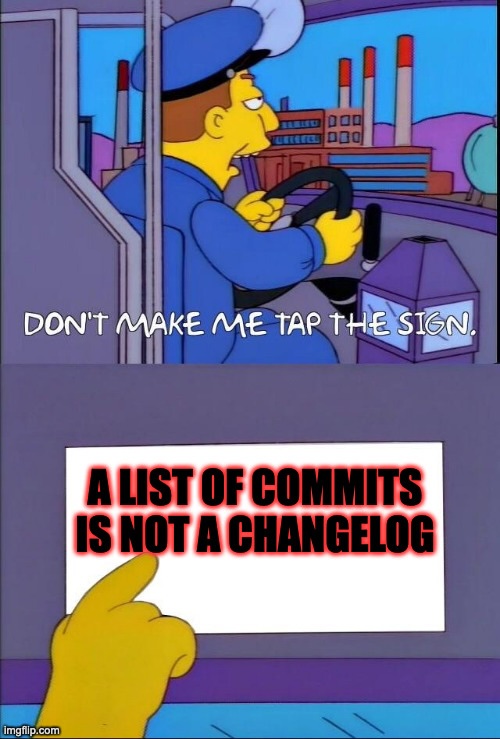Club.noww.in
I playfully quipped about changelogs, and Sumana Harihareswara thoughtfully responded with Changelogs and Release Notes. I agree with her on some things, and disagree on others.
My point with the meme was that people should put effort into a hand-crafted description of what has changed in each release of their product. It should be focused on what users need to know, and not include internal changes, which can be found in the git commits or pull requests. It’s easy to publish a list of commits or pull requests and call it a changelog, but it’s not that helpful to your users trying to understand what has changed for them. That was the point of the meme.
But Sumana raised the stakes, explaining why projects should produce two hand-crafted descriptions. The first is a changelog which mentions every non-trivial change. The second are release notes which should be user-focused with more details.
I liked the reasons Sumana gave:
- Release notes can include project-level information that doesn’t correspond to a particular change in a release. Maybe you started a new discussion forum, or there’s a shift in maintainer attention, plans for upcoming work, and so on.
- If the release notes are user-focused, then the changelog can be more comprehensive, giving people a fuller picture of the work that goes into producing the project. This can pull back the curtain, helping people understand the inner workings of the project and perhaps find a way to help out.
My problem with separating the changelog and release notes is that I have limited energy to produce them, and perhaps more importantly, people have limited attention to read them. For my projects, I opt instead for a middle ground: my changelogs lean more toward Sumana’s ideal of release notes. They are hand-written, focused on what users of the project need to know, and do not include things like build changes and refactorings.
For large projects like Python and Linux, there are many maintainers and many types of information, so it makes sense to have multiple views of “what’s changed.” For single-maintainer projects, it feels like too much. I applaud people who can do it, but I don’t think I can, and I won’t expect it from others.
Ultimately, each project has to decide for themselves how to balance the effort and the benefit. They know their audience(s), and what resources they have to do the work. Open source is already difficult, the last thing I want to do is add a giant SHOULD to a project.
There’s an inexact nested ratio at work in projects: Most users (say 90%) will only consume, you will never hear from them. You hear from the remaining 10%, but only 10% of those will do something you consider a contribution. For widely used projects like coverage.py, I think the ratio might be more like 1% of 1% instead of 10% of 10%. How does this affect your communication approach? You could look at it two ways: either write for the audience you have (focus on the 90%), or write for the audience you want (focus on the 10%).
In my changelogs now, for fixes I try to describe the bad thing that used to happen and any important changes in behavior. For features, I link to the new docs. I include links to issues and pull requests, and I name the contributors who helped.
So I guess my approach is to write changelogs for the 90%. But I like Sumana’s idea of making the full picture of maintainence more visible to people, so I’m thinking about how to add that without changing the essential character of my changelog. Perhaps something at the end summarizing the changes that aren’t yet mentioned, with a link to the git history? I’m not sure I can automate collecting that information, but I’ll have to play with it.













 English (US)
English (US)